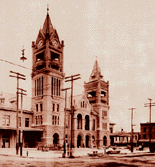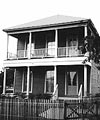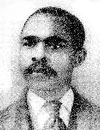Women's
History Tour of Early Houston:
Historic Marker Information and Web Sites for Resources
1. Site of the Jane Harris house and Glendale Cemetary
Jane Harris House
Mary Jane Harris Briscoe (1819-1903) was a Houston civic leader and founder of the Daughters of the Republic of Texas.
- Short Biography of Mary Jane Harris Briscoe
http://www.tsha.utexas.edu/handbook/online/articles/view/BB/fbr59.htmlGlendale Cemetary, Lavaca at E. Magnolia
Historic Marker Number: 10670Text from the marker:
Burial place, Texas heroes and pioneers. Began as private plot of family of John R. Harris, founder of Harrisburg (now part of Houston). First burial, on July 23, 1839, was of Mrs. Harris' cousin, Judge John Birdsall, an ex-attorney general of texas. A cemetery developed without management or legal status. In 1897, local ladies formed Glen Dale Cemetery Company and kept grounds in order for years. After a period of neglect, a group began restoration in 1952. Glendale Cemetery Association, Inc., now manages the property and provides perpetual care.More information about the cemetery:
Glendale Cemetery is surrounded on three sides by railroads, industry and the Port of Houston and Houston Ship Channel. It was established in 1826 and is the oldest cemetery within Houston city limits. It was originally the burial ground of the Harris family but some sailors who died while in port were also buried there. Eventually Glendale became a community graveyard. A pink granite marker inscribed "Infant's Rest" commemorates 21 unnamed children who were buried here.Harrisburg
Historic Marker Number: 10680Text from the marker:
Early Texas port and trading post. Site of state's first steam saw, grist mills and railroad terminal. Town founded, 1826, by John R. Harris, who was first settler in 1823. Became shipping center for early colonies, established when Texas was part of Mexico, with boats carrying cargo to and from Texas ports and points in the United States and Mexico. Became the seat of government of the Republic of Texas, March 22 - April 13, 1836, when David G. Burnet, President of the ad interim government and several of his cabinet resided near here in the home of Mrs. Jane Harris (site marked), widow of town founder. Here President Burnet adopted the flag for the Texas Navy. In 1835, local resident, Mrs. Sarah Dodson, had made here the first tri-color lone star flag. General Santa Anna attacked the town with 750 Mexican soldiers on April 16 attempting to capture Burnet and his cabinet. The whole town was burned. After Texas gained its independence at nearby San Jacinto, the town was rebuilt and again thrived. The Buffalo, Bayou, Brazos and Colorado, first railroad in Texas began here in 1852 and by the Civil War made the town a Confederate rail center. Became a part of Houston, by annexation, in 1926.
2. Site of Charlotte Allen house, NW corner of Main and Rusk Street
(1805-1895). Charlotte Allen is called "the mother of Houston."
- Short
biography of Charlotte Allen
http://www.tsha.utexas.edu/handbook/online/articles/view/AA/fal84.html
3. Scanlan Building, 405 Main Street
The Scanlan Building occupies the site of what used to be the Executive Mansion. It was a private one-and-a-half story home with dormer windows, built by Francis Lubbock in 1837. That same year the Republic of Texas bought the house for use as the Executive Mansion. Two presidents, Sam Houston and Mirabeau Lamar, lived there during their terms of office.
4. Christ Church Cathedral, NE corner of Fannin and Texas
Historic Marker Number: 10631
Text from the marker:
The second Episcopal parish in the Republic of Texas. Led by a missionary of the Episcopal Church in the United States, the Rev. R.M. Chapman, and by an early Houstonian, Col. William Fairfax Gray, thirty-nine men came together on March 16, 1839, to organize an Episcopal Church, and on Easter Monday, April 1, 1839, Christ Church was officially established. Some of the first service were held in the Capitol of the Republic, then at the corner of Main Street and Texas Avenue. In 1844 a wooden building on this site served as a church. In 1846 it was supplanted by a brick structure. In 1859 a second brick church was begun, then enlarged in 1876. Present building was erected in 1893, its altar area rebuilt after a fire in 1938. The original cornerstone may be seen inside the church. Founded under the Rt. Rev. Leonidas Polk, missionary bishop, and often visited by his successor, the Rt. Rev. George Washington Freeman, the parish was guided and nurtured by the Rt. Rev. Alexander Gregg, first bishop of the Diocese of Texas, and by the Rt. Rev. George Herbert Kinsolving, second bishop. It became in 1949 the Cathedral of the Diocese under the Rt. Rev. Clinton s. Quin, third bishop.
5. Incarnate Word Academy, 1611 Capitol Avenue
Historic Marker Number: 10588
Text from the marker:
First permanent Catholic school in Houston. Established by Sisters of the Incarnate Word and Blessed Sacrament, a religious order founded 1625 in Lyons, France. In 1852, at request of the First Bishop of Texas, the Rt. Rev. John M. Odin, the order entered the United States to engage in religious education. The sisters opened their first school in Brownsville in 1853; second in Victoria, 1866; and the third here. Mother M. Gabriel Dillon and two sisters came to Houston in 1873 at request of the Rev. Joseph Querat, to begin teaching young girls in temporary quarters at the old Franciscan Monastery on Franklin. By Jan. 3, 1874, their own 3-story edifice was finished. Facing Crawford, it had a courtyard bounded by Capitol and Jackson. Boarding facilities opened in a few months. A State of Texas Charter empowered the Academy to issue diplomas, beginning in 1878. In 1899, the Exhibition Hall (auditorium) was built. To accommodate growth, another 3-story structure was added, 1905. Original building was replaced in 1948. 200 to 300 pupils annually have learned devotions, arts, and sciences under dedicated tutelage of the sisters, who have watched Houston grow from a small, muddy town into a city of cosmopolitan culture.
6. Site of Mary Jane Harris Briscoe house, 620 Crawford Street
Daughters of the Republic of Texas
Historic Marker Number: 10646
Text from the marker:
On November 6, 1891, seventeen women met at the home of Mrs. Andrew Briscoe at this site to organize an auxiliary to the Texas Veterans Association. Mrs. Anson Jones was elected president of the new organization, Daughters of the Lone Star Republic. Goals set for the group included preserving the memories of Texas Revolution heroes, instilling Texas patriotism in the state's school children, preservation of historic sites, and promoting statewide celebrations of Texas Independence Day (March 2) and San Jacinto Day (April 21). The first annual meeting of the organization was held in Lampasas on April 21, 1892. A resolution was passed to change the group's name to the Daughters of the Republic of Texas. By 1892 the first two chapters had been formed, one in Galveston and one in Houston. The DRT has been in the forefront of many historic preservation projects throughout the state. Clara Driscoll, on behalf of the D. R. T., wrote personal checks to save the Alamo from demolition. The organization also led efforts to preserve and commemorate the San Jacinto Battlefield site, and maintains the old General Land Office and French Legation buildings in Austin as museums. Texas Sesquicentennial 1836 - 1986.
7. Headquarters of the Texas Grand Court of Calanthe, 2411 Dowling Street
8. Married Ladies' Social, Art, and Charity Club, 1814 Southmore
- A short
biography of Jennie Covington
http://www.tsha.utexas.edu/handbook/online/articles/view/CC/fcoyp.html
9. Site of Jennie Covington house, 2219 Dowling
Historic Marker Number : 10642
Text from the marker:
Dr. Benjamin Jesse Covington (c. 1871-1961), his wife Jennie Belle Murphy (1881-1966), and the stately home they built here in 1911 represented a level of achievement, dignity, and civic service matched by few African Americans in Houston during the first half of the 20th century. Born and reared on a farm in Falls County, Texas, Dr. Covington exhibited surgical skills on farm animals at an early age. He later attended Hearne Academy and Meharry Medical College to become a surgeon. After graduating in 1900 he began his medical practice in Wharton, Texas. He married Gonzales native Jennie Belle Murphy in 1902, and in 1903 they moved to Houston where Dr. Covington practiced medicine for 58 years. Dr. Covington, president of the Lone Star Medical Association in 1920, co-founded the Houston Negro Hospital in 1925. Mrs. Covington co-founded the Blue Triangle Branch, Y. W. C. A., and served as chair of the Texas State Commission on Race Relations. The Covingtons were active members of Antioch Baptist Church. During a period when local hotels were segregated, the Covingtons' home (razed in 1978) served as Houston's unofficial guest quarters for many prominent African American visitors including Booker T. Washington and eminent artists Marian Anderson and Roland Hayes. (1994)
10. Julia Ideson Building, 500 McKinney
Julia Ideson, 2nd from left, with library staff
Historic Marker Number: 10698
Text from the marker:
Genesis of Houston Public Library system. Outgrowth of Houston Franklin Debating Society, founded 1837, the first Houston Lyceum was chartered by the State of Texas on March 20, 1848. Its founders were Thomas M. Bagby, Abner Cooke, Peter W. Gray, T. B. J. Hadley, E. A. Palmer, James Walker, and other citizens interested in debating and in a circulating library. Meetings of this group lapsed, and a second Houston Lyceum was organized on May 27, 1854, by Andrew W. Daly, who became president. C. R. Smith was vice president; W. I. Brocket, recording secretary; S. C. West, corresponding secretary; T. H. Conklin, treasurer; and Thomas Pearce, librarian. Aim, similar to that of first Lyceum, was "to diffuse knowledge...by a library, by lectures..., and by discussion...." Some $17.40 and 88 volumes were collected by Aug. 25, 1854. A bookcase was bought, and library was lodged in the county courthouse. Lyceum activities were curtailed in Civil War era (1861-65), but library and records were preserved until his death in 1868 by the faithful president, Andrew Daly. The Lyceum was reactivated in 1874. Houston Public Library, inheritor of the Lyceum's books and ideals, is now a major resource center for one-fourth of the population of the State of Texas.
- Short
biography of Julie Ideson
http://www.neosoft.com/~sgriffin/houstonhistory/ghoustonians/history8y.htm - History
of the Houston Public Library
http://www.hpl.lib.tx.us/hpl/libhist.html
11. Rutherford B. H. Yates house, 1314 Andres Street
Historic Marker Number: 11691
Text from the marker:
Rutherford Birchard Hayes Yates (1878-1944), son of the Rev. John Henry "Jack" and Harriet Yates, grew up next door to this property (in a house later relocated to Sam Houston Park.) Yates followed in his father's footsteps as a civic and religious leader in Houston's Fourth Ward, originally known as Freedmen's Town, a spiritual, cultural and business district for African Americans in Houston since the Civil War. Following his graduation in 1906 from Bishop College in Marshall, Texas, with a degree in printing, Rutherford Yates taught school in Vinto, Louisiana, and Palestine, Texas, before moving to Dallas with his wife, Erie (Sherrod), and their infant daughter. In 1908, they moved to Houston and resided in the Yates family home until this house was completed in 1912. A well-preserved and typical example of the middle class residences built in the Fourth Ward in the early 20th century, the Yates house features leaded glass windows, a wraparound porch with Classical columns, and doors with transoms and sidelights. During the time that the Yates family occupied this house, Rutherford Yates worked with several African American printers and taught at the Houston Academy (founded by his father) where he had attended school as a young boy. In 1922, he and his brother Paul established the Yates Printing Company, which grew and prospered over the years until it closed after 1978. At a time when commercial lodging for African Americans in Houston was limited, Rutherford and Erie Yates and their children -- Johnnie Mae, Olee and Rutherford -- often opened their home to visiting dignitaries and delegates to church and other conventions. The house remained in the Yates family ownership until 1994. Recorded Texas Historic Landmark-1998.
Resources:
 |
Texas
Historic Sites Atlas The Atlas features more than 200,000 historic site records, including data on Texas Historical Markers and National Register of Historic Places properties in Texas, as well as museums, and sawmills. Search our database to discover the sites that make your hometown unique. Click the Atlas' interactive maps to display historic site locations, and plan your own heritage tour of Texas. |
|
|
|
||
| Buffalo
Bayou: An Echo of Houston's Wilderness Beginnings by Louis F. Aulbach and Linda C. Gorski http://www.hal-pc.org/~lfa/Buffalo.html These articles about Buffalo Bayou are exerpted from the forthcoming book by Louis Aulbach and Linda C. Gorski entitled "Buffalo Bayou: An Echo of Houston's Wilderness Beginnings." The book is a hiking, biking and paddling guide to Buffalo Bayou from its origin in Fort Bend County to the Sidney Sherman Bridge (I-610 East). |
||
 |
Houston
Timeline 165
Years of Houston History Blacks
in Houston Today |
|
 |
Yates
House, constructed in 1870 by freed slave Jack Yates, who became
one of Houston's most prominent religious leaders and a true advocate
of education for African-Americans in the post Civil War period. More
about Jack Yates: More
about the Fourth Ward: |
|
 |
The
Rutherford B. H. Yates Museum, |
|
| The
Heritage Society |
||
| Information about Houston's Wards:
|